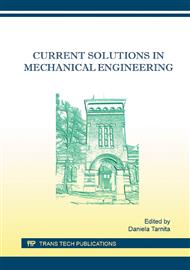[1]
A. Qazi, H. Fajaz, A. Wadi, R. G. Raj, N. A. Rahim and W. A. Khan, The artificial neural network for solar radiation prediction and designing solar systems: a systematic literature review, Journal of Cleaner Production 104 (2015) 1 – 12.
DOI: 10.1016/j.jclepro.2015.04.041
Google Scholar
[2]
M. Lazzaroni, S. Ferrari, . V. Piuri, A. Salman, L. Cristaldi and M. Faifer, Models for solar radiation prediction based on different measurement sites, Measurement 63 (2015) 346 – 363.
DOI: 10.1016/j.measurement.2014.11.037
Google Scholar
[3]
R. R. Bhoyar and S. S. Bharatkar, Renewable energy integration in to microgrid: Powering rural Maharashtra State of India, Anual India Conferencia, Mumbai, (2013).
DOI: 10.1109/indcon.2013.6725877
Google Scholar
[4]
T. R. Ayodele and A. S. O. Ogunjuyigbe, Prediction of monthly average global solar radiation based on statistical distribution of clearness index, Energy (2015).
DOI: 10.1016/j.energy.2015.06.137
Google Scholar
[5]
J. C. War, Seawater Air Conditioning (SWAC) a renewable energy alternative, OCEANS 2011, Waikoloa, (2011).
DOI: 10.23919/oceans.2011.6107219
Google Scholar
[6]
A. J. C. Trappey, C. V. Trappey , D. Y. C. Wang, S. J. Li and J. J. R. Ou, Evaluating renewable energy policies using hybrid clustering and analytic hierarchy process modeling, International Conference on Computer Supported Cooperative Work in Design (CSCWD), 18th ed., Hainchu, (2014).
DOI: 10.1109/cscwd.2014.6846933
Google Scholar
[7]
R. Nagaraj, Renewable energy based small hybrid power system for desalination applications in remote locations, International Conference on Power Electronics (IICPE), 5th ed., Delhi, (2012).
DOI: 10.1109/iicpe.2012.6450437
Google Scholar
[8]
J. Chen, S. Xiang and P. Ghosh, Energy efficient algorithms for Electric Vehicle charging with intermittent renewable energy sources, Power and Energy Society General Meeting (PES), Vancouver, (2013).
DOI: 10.1109/pesmg.2013.6672568
Google Scholar
[9]
C. Jin, X. Sheng and P. Ghosh, Optimized Electric Vehicle Charging With Intermittent Renewable Energy Sources, IEEE Journal of Selected Topics in Signal Processing 8 (2014) 1063 – 1072.
DOI: 10.1109/jstsp.2014.2336624
Google Scholar
[10]
J. Han, C. Choi, W. Park, I. Lee and S. Kim, Smart home energy management system including renewable energy based on ZigBee and PLC, IEEE Transactions on Consumer Electronics 60 (2014) 198 - 202.
DOI: 10.1109/tce.2014.6851994
Google Scholar
[11]
R. Mohideen, The implications of clean and renewable energy development for gender equality in poor communities in South Asia, Conference on Technology and Society in Asia (T&SA), Singapore, (2012).
DOI: 10.1109/tsasia.2012.6397976
Google Scholar
[12]
C. Kang-Ching, K. Kaifuku and K. Saitou, Optimal integration of alternative energy sources in production systems for minimum grid dependency and outage risk, International Conference on Automation Science and Engineering (CASE), Taipei, (2014).
DOI: 10.1109/coase.2014.6899395
Google Scholar
[13]
Y. Badruzzaman, Sarjiya and A. Nur Widiastuti, Roadmap energy in special region of Yogyakarta to empower renewable energy source, International Symposium on Technology Management and Emerging Technologies (ISTMET), Bandug, (2014).
DOI: 10.1109/istmet.2014.6936520
Google Scholar
[14]
L. Olatomiwa, S. Mekhilef, S. Shamshirband, K. Mohammandi, D. Petkovic and C. Sudheer, A support vector machine–firefly algorithm-based model for global solar radiation prediction, Solar Energy 115 (2015) 632 - 644.
DOI: 10.1016/j.solener.2015.03.015
Google Scholar
[15]
X. Juncai, R. Qingwen and S. Zhenzhong, Prediction of the strength of concrete radiation shielding based on LS-SVM, Annals of nuclear energy 85 (2015) 296 - 300.
DOI: 10.1016/j.anucene.2015.05.030
Google Scholar
[16]
M. A. Shamim, R. Remesan, M. Bray and D. Han, An improved technique for global solar radiation estimation using numerical weather prediction, Journal of Atmospheric and Solar-Terrestrial Physics 129 (2015) 13 -222.
DOI: 10.1016/j.jastp.2015.03.011
Google Scholar
[17]
L. Olatomwa, S. Mekhilef, S. Shamshirband and D. Petkovic, Adaptive neuro-fuzzy approach for solar radiation prediction in Nigeria, Renewable and Sustainable Energy Reviews 51 (2015) 1784 - 1791.
DOI: 10.1016/j.rser.2015.05.068
Google Scholar
[18]
S. Salcedo-Sanz, C. Casanova-Mateo, A. Pastor-Sanchez and M. Shanchez-Giron, Daily global solar radiation prediction based on a hybrid Coral Reefs Optimization – Extreme Learning Machine approach, Solar Energy 105 (2014) 91 - 98.
DOI: 10.1016/j.solener.2014.04.009
Google Scholar
[19]
S. S. Devgan, Impact of environmental factors on the economic evaluation of renewable energy alternative generation, Proceedings of the 33rd Southeastern Symposium on System Theory, 33rd ed., Athens, (2001).
DOI: 10.1109/ssst.2001.918503
Google Scholar
[20]
Y. Wu, V. K. N. Lau, D. H. K. Tsang, P. Q. Li and M. Limin, Optimal Energy Scheduling for Residential Smart Grid With Centralized Renewable Energy Source, IEEE Systems Journal 8 (2014) 562 - 576.
DOI: 10.1109/jsyst.2013.2261001
Google Scholar
[21]
K. S. Herman, Attracting foreign direct investment the Chilean government's role promoting renewable energy, International Conference on Renewable Energy Research and Applications (ICRERA), Madrid, (2013).
DOI: 10.1109/icrera.2013.6749722
Google Scholar
[22]
M. H. Barcellos-Hoff, E. A. Blakely, S. Burma, A. J. Fornace Jr., S. Gerson, L. Hlatky, D. G. Kirsch, U. Lederer, J. Shay, J. Wang and M. M. Weil, Concepts and challenges in cancer risk prediction for the space radiation environment, Life Sciences in Space Research 6 (2015).
DOI: 10.1016/j.lssr.2015.07.006
Google Scholar
[23]
M. Peña, H. Alvarez and R. Carelli, Modelo e identificacion con un modelo borroso del tipo takagi -sugeno, V Jornadas de Sistemas de Instrumentación y Control, Caracas, (2000).
Google Scholar
[24]
P. W. Stackhouse, NASA Prediction of Worldwide Energy Resource (POWER), NASA, information on: http: /power. larc. nasa. gov/cgi-bin/cgiwrap/solar/timeseries. cgi?email=daily@larc. nasa. gov.
Google Scholar
[25]
M. Fathi, M. Mohebbi y S. M. Ali Razavi, Application of Image Analysis and Artificial Neural Network to Predict Mass Transfer Kinetics and Color Changes of Osmotically Dehydrated Kiwifruit, Food and Bioprocess Technology 4 (2011) 1357 – 1366.
DOI: 10.1007/s11947-009-0222-y
Google Scholar
[26]
R. Tapia Herrea, Seguimiento de referencias aplicadas en manipuladores robóticos, Mexico, (2013).
Google Scholar
[27]
O. Castillo, J. Kacprzyk and W. Predycz, Soft Computing for Intelligent Control and Mobile Robotics, Springer, Berlin, (2010).
Google Scholar


